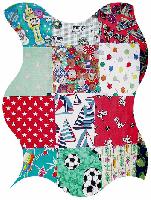
This lesson emphasizes making personal connections to a text to enhance reading comprehension. Children are motivated by talking about themselves and what they know. This lesson is based on a teacher's interest in quilts, a book that involves a quilt, and quilts for props, but can be adapted to other interests by changing the book and props.
Children will learn to make a habit of searching for text-self or text-world connections.
The Quilt by Ann Jonas. Props: A doll's quilt or other small quilt (preferably made of scrap squares), some stuffed animals to cover with the quilts, large paper to write on, a big marker. If possible, find a floppy Clifford stuffed dog or other stuffed dog that looks a lot like the stuffed animal in the book. Arrange fabric squares of designs and colors similar to the ones in the book (sailboats, balloons) on a felt board.
This lesson was based on Chapter 6 of the book "Strategies that Work: Teaching Comprehension to Enhance Understanding" by Stephanie Harvey and Anne Goudvis, Stenhouse Publishers, Portland, ME, 1999
1. The teacher talks about the reasons he/she chooses a book (modeling connections); the books she/he chooses to read often remind the teacher of something in his/her own life
2. The teacher talks about the props that are arranged near the reading area to generate some curiosity and interest in the book. The props are connected to the teacher's life, (Quilting) and this connection is explained. The process of sewing together quilt squares can be described, and a few quilt squares on the flannel board that look like the significant ones in the book are examined. Kids should be able to mention some of the things they see in the squares (dots, hearts, dogs, boats, soccer balls, robots, etc.). Quilt squares can be passed around.
3. The teacher talks about the book to be read, the connections to the props and the connections to the teacher. Use the words, "This book reminds me of" to start the sentences describing the connections. For example, "This book reminds me of a quilt I made for my daughter."? "These fabric squares remind me of the squares in the quilt on the cover of the book."
4. The teacher writes on one side of the Big Paper, "The story reminds me of," and reads this statement to the children.
5. The teacher explains that as he/she reads, the children can raise their hands if they would like to share something the story reminds them of.
6. The teacher reads the story, stopping when the children put up their hands.
7. The teacher writes children's words or phrases that can finish the sentence, "The story reminds me of..."
8. When the stuffed animal in the book (Sally) appears, the teacher says that Sally reminds her/him of Clifford or similar floppy stuffed dog (unless the children make this connection first)
9. The book's illustrations show certain quilt squares that become scenes in the main character's dream. Point out those squares in the beginning (there's a square with sailboats; some others look like the circus tents, etc.). When the related scenes come up in the story, the children may remember the connection. If you have brought fabric squares that look like the ones in the book, they can be mentioned, too. (This picture of sailboats reminds me of the sailboat quilt square, for example)
10. At the end of the story, the teacher reviews the chart with the students. Restate that books mean more to us when they remind us of something in our life. (If book exchange follows this lesson, ask the children to look for a book that reminds them of something in their life. )
Ask for volunteers to imagine they were talking to their parent or to an absent classmate and describe what they learned in the lesson.
National Information Literacy Standards (K-12)
Appreciates literature and other creative expressions of information.
Information Skills and Subskills (K-16)
Selection
National Content Standards (K-12)
Reading